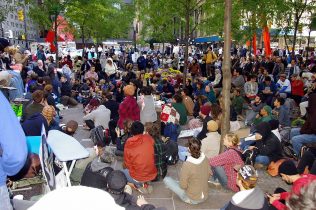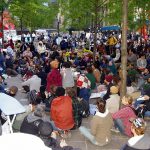
(Courtesy of Wikimedia Commons, 2011)
Occupy Wall Street was a movement initiated in 2011 to protest the corporate greed and widespread economic inequality that was experienced across New York and the country as a whole. This protest consumed the city, as tens of thousands of individuals participated, and the protest dominated the news cycles for months. New York itself played a key role in this protest, as it represented both the center for economic prosperity in the United States, but also a constant reminder of the financial inequality inherent within the city itself. The efforts by the protesters also consumed the physical space of the city, as multiple unique facets were utilized within the protest to contribute to its effectiveness. Occupy Wall Street was a profound moment in the history of New York City, as it stood up for values held by many, against the power held by a few.
Michael Moore described Occupy Wall Street as being made up of those who “have lost their jobs, their homes, their ‘American Dreams’”[1]. While the movement was composed of thousands of individuals, their backgrounds and perspectives on the issues addressed in the protest were diverse and far-reaching. Originally a protest started by the youth in the city, it later spread to include an expansive range of New Yorkers. One protester commented “But the wider movement is remarkably more diverse than it’s been portrayed. I’ve seen a lot of first-time protesters, nurses, librarians. At one protest, the younger element seemed actually to be in the minority”.[2] The diversity of the protest was indicative of the expansive elements of inequality felt by Americans, both in New York and outside of it. A diverse community of protesters created a collective mentality and unity among them. As they began to flood the streets, it was clear that Occupy Wall Street was not a movement concentrated with one single group, but of an entire population. Although the protesters had varied backgrounds, some traveling in from New Jersey or Connecticut to take part in the protests, each protester embodied the spirit of the city throughout the duration of these protests.[3]
The rallying cry for these passionate New Yorkers became “we are the 99%”, indicating the quantity of wealth held by the extremely elite of the city compared to the masses while also commenting on the sheer size of the movement in comparison to the elites.[4] This rhetoric expanded to include other powerful chants, all accusing the banking industry with uncontrollable greed and predatory practices against the less privileged.[5] One author described the central theme of the protest as “driven by ‘anxiety about the economy [and] belief that big institutions favored the reckless over the hard-working”.[6] These themes were central to the efforts of Occupy Wall Street, as the protesters banded together, joining their voices as one and fighting for the economic privileges that had been withheld for years.
While this movement encompassed the attitudes of thousands of New Yorkers and millions of Americans, it did not come without controversy. The majority of protests during the movement remained peaceful, but incidents occurred that shed a negative light on the movement as a whole. One example of this was an episode in which a protester was accused of assaulting a police officer. Following a court case that concluded in 2014, this protester was found guilty after videos of her lunging at a police officer and wounding their face. However, this individual was one of the only protesters arrested during Occupy Wall Street.[7] In addition to this event, one protest spiraled out of control when police officers used pepper spray on peaceful protesters.[8] This became extra motivation for the protesters, as they used this as a greater fuel for the movement going forward.
Taking place in the Lower East Side of Manhattan, the protesters used New York City itself as a tool for the movement. Inherent in the Occupy Wall Street movement is the usage of private space for the protest against their owners. For the duration of the protest, the financial district of the city was truly occupied, as protesters used tents to camp overnight and consistently continue the protest.[9] “Space, therefore, is central in OWS because it is a movement not only ‘organized in space’ but also ‘about space’”.[10] The usage of public space for protest was conceptualized with intentionality, designed to create an image of repugnance for their movement, impressed upon the wealthy. One author argues that the protesters utilized “an aesthetic of disgust” in an effort to repulse the Wall Street elites.[11] These efforts intentionally created a reputation for the movement, as the protesters made little effort to look polished or elite during their efforts. This was a protest of the everyday Americans, individuals who considered themselves to be the working class of the city.

(Courtesy of Wikimedia Commons, 2011)
The protesters specifically settled in Zuccotti Park, located in the Lower East Side of Manhattan. The Park was considered to be a “privately owned public space”, operated by Goldman Sachs.[12] This paradoxical classification of space has drawn criticism, as it gives considerable spatial power to the corporations that control the areas.[13] While there were no laws governing the usage of this property, the utilization for a long term protest and occupation were in direct opposition to the bank’s intentions of operating the space. Just as the protesters worked to tear down the beautification processes the city had been undergoing for years, the usage of this space represented the institutions the movement aimed to diminish. Zuccotti Park became a symbol for this movement and the hub for Occupy Wall Street throughout the entire protest.
Zuccotti Park served to make Occupy Wall Street an incredibly visible protest, as it was impossible to be in this region of the city without sight of the movement. The park was a popular site for visitation before the protest, and by taking over the physical space in such a dramatic fashion, the protest dominated news cycles and conversations for weeks.[14] Wall Street workers themselves were forced to encounter Occupy Wall Street, a constant reminder of the values of the protest and the insinuation of guilt for these wealthy members of society.
This protest ended in November of 2011, as the New York Police Department (operating under the guidance of Mayor Michael Bloomberg) raided Zuccotti Park and cleared it of protesters, as it was to be cleaned. Allegedly, the police removed tarps and tents from the park and began placing them into dumpsters.[15] Despite the end of the protest in New York, the movement spread into an even larger movement, labeled as simply “Occupy”. This movement is sometimes associated with anarchism, but largely stands for the ideology of the original protest, fighting against the greed that has dominated the United States for decades. Although the Occupy Wall Street movement was abruptly ended, it had far-reaching implications for the wide range of economic protests that have occurred in the years since the occupation of Zuccotti Park.
Occupy Wall Street is a movement rooted in the culture and history of New York City itself. While it utilized the public space that the city had been famous for, it also embodied the spirit of the city. The protests joined thousands of people under a common cause, as they joined together in protest of the oppressive actions of the wealthiest elites. While New York City is an economic center of the United States, it also represents the worst of economic inequality in the country. The diversity of the movement brought a wide range of backgrounds and perspectives together, as they fought for the bettering of economic conditions. The unity of such a diverse group made this protest representative of the city itself. Every background is represented throughout the city, as it is one of the most culturally diverse places in the world. Occupy Wall Street brought the people of the city together through the creation of a common enemy.
[1] Michael Moore, “The Purpose of Occupy Wall Street is to Occupy Wall Street” (Nation 294, no. 14, April 2012), 12.’”
[2] Jocelyn Novek, “Protesters Want World to Know They’re Just Like Us”, Long Island Press, October 10, 2011.
[3] Ibid.
[4] Anonymous, “Origins of Occupy Wall Street; As Occupy Wall Street commemorates its one-year anniversary on Sept. 17, here is a look back at the early days of the movement in Lower Manhattan.” Wall Street Journal, September 15, 2012, 1.
[5] Novek.
[6] Anthony Dimaggio and Paul Street, “Occupy Wall Street, Mass Media and Progressive Change in the Tea Party Era”, Economic and Political Weekly 46, no. 47 (November 2011), 10.
[7] James McKinley Jr., “Woman Found Guilty of Assaulting Officer at an Occupy Wall Street Protest”, The New York Times, May 6, 2014, 20.
[8] Mother Jones News Team, “Occupy Wall Street, a Global Movement”, Mother Jones, October 4, 2011.
[9] Hao Cao, “A Noneventful Social Movement: The Occupy Wall Street Movement’s Struggle Over Publicly Owned Private Space” International Journal of Communication 11, 2017, 3163.
[10] Ibid.
[11] Luke Winslow, “Not Exactly a Model of Good Hygiene’: Theorizing an Aesthetic of Disgust in the Occupy Wall Street Movement”, Critical Studies in Media Communications 34, no. 3, 2017, 278.
[12] Cao.
[13] Ibid.
[14] Ibid.
[15] Joe Weisenthal and Robert Johnson: “Here’s How Occupy Wall Street Came to a Sudden, Unexpected End Today”, Business Insider, November 15th, 2011.
Brooklyn Bridge
One significant protest during Occupy Wall Street took place on the Brooklyn Bridge, resulting in the arrest of many protesters. This was one of the rare occasions of Occupy Wall Street moving out of Zuccotti Park.
New York Stock Exchange
At the center of the Occupy Wall Street movement was the New York Stock Exchange. The protesters intentionally set up camp close to this building, and targeted the values the stock exchange stood for, including corporate greed and income inequality.
Occupy Wall Street

Occupy Wall Street was a movement initiated in 2011 to protest the corporate greed and widespread economic inequality that was experienced across New York and the country as a whole. This protest consumed the city, as tens of thousands of individuals participated, and the protest dominated the news cycles for months. New York itself played ...
Zuccotti Park
Zuccotti Park was home to the majority of the Occupy Wall Street protesters, as they camped out with tents and tarps during the duration of the movement. This park was cleared out by the NYPD, signaling the end of the protest.